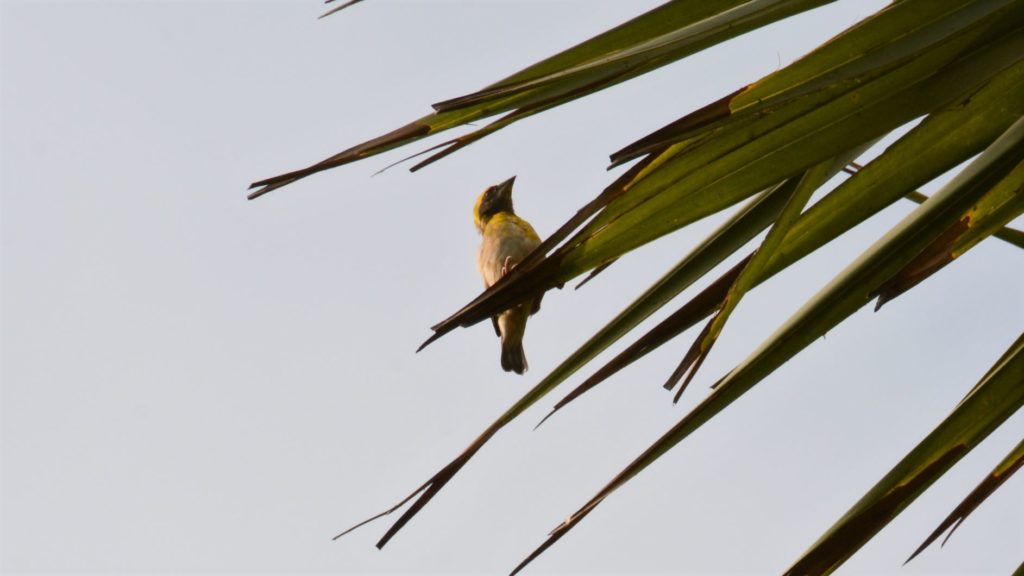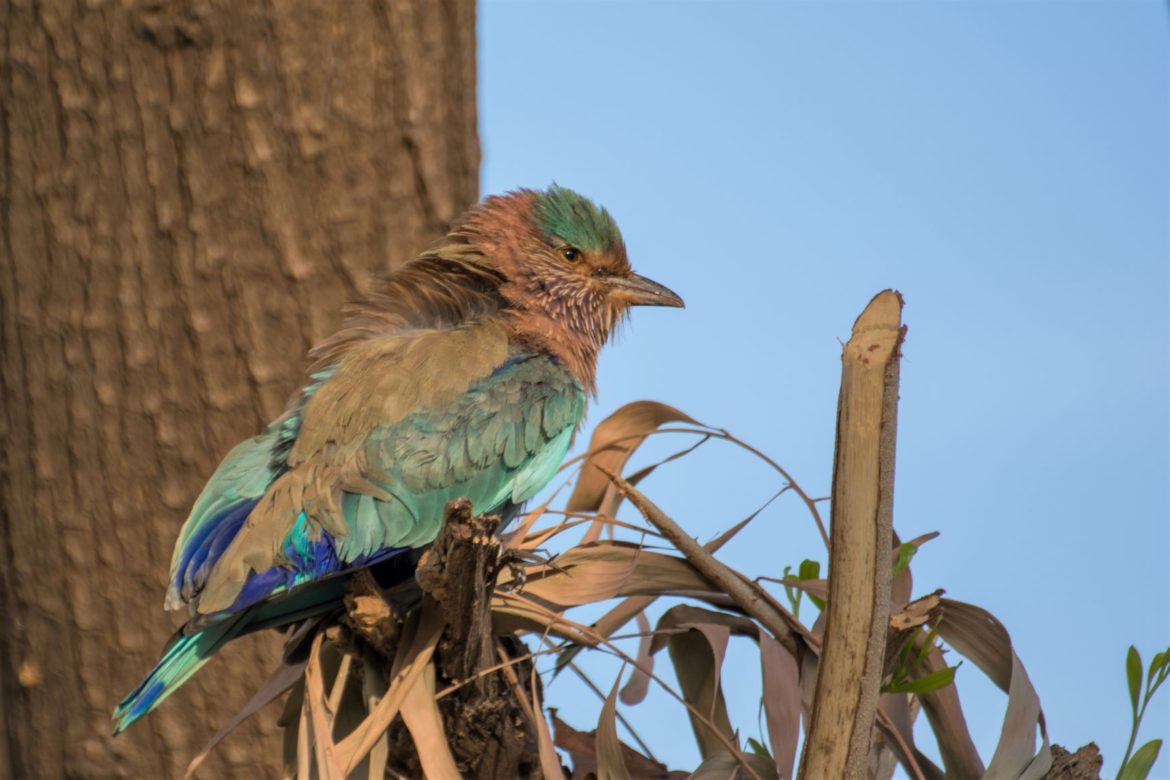Birding often throws up surprises. One such is this vibrant bird, the Indian Roller, which we have seen occasionally on the campus.
Every year, before the onset of monsoon, a bunch of Baya Weavers arrived at the campus to build their colony on one of the palm trees by the Gymkhana. Their intricately woven nests, true architectural marvels, hung suspended from the palm fronds high above the human eye. I wonder how many passing by the tree registered the yellow specks busily flashing past in the sky (the breeding male Baya assumes a yellow crown).
Baya Weavers are as small as House Sparrows. To an undiscerning eye, they even look similar. While they are not residents of the campus, they are found in good numbers at the next-door Bhandup Pumping Station. For breeding alone, they came to IITB. Typically, the males arrived first to build their elegant nests that resemble blown glass and win over the females. For those unfamiliar with the ways of the Baya, do read ornithologist Sálim Ali’s fascinating field observations of its nesting habits in the Journal of the Bombay Natural History Society, available on the internet.

A male Baya Weaver inspects a Palm Tree adjacent to the Gymkhana in May 2016 before abandoning the idea to build its nest. The tree hosted a Baya Weaver colony regularly until 2015.
In the year 2016, as the scrub skirting the gymkhana grounds made way for the new courts, the Bayas did arrive in the month of May, like clockwork. We noticed some of them on the palm fronds, as if on an inspection, but they never built their nests that year. Ever since, the Bayas have vanished from the campus unnoticed, unregistered.
Before I go on, I must add a disclaimer. This article is not about how birds have disappeared from the campus over time with development. I’m not an ornithologist nor a conservationist to reflect on such a serious matter. Nor is the article an assessment of the birds found in IITB or an investigation into its declining biodiversity. For the former, we have Dr. Goldin Quadros-led WWF study of IITB biodiversity though over ten years old, and for the latter, we have an in-depth article in March 2020 Insight by Ganesh Chelluboyina, who recently graduated from IITB. In my story, I merely want to draw attention to the things we do not see and register. And how in our claim over everything nature has to offer— its space, air, or the privilege of a lake or a hill—we forget life works best in symbiosis.
Some ten years ago, the hypnotic effect of a big-eyed large grey, white and black bird that perched on the tree opposite my window at Staff Hostel every single day rendered me a birdwatcher. The bird, I discovered, was a Black-crowned Night-Heron. It was the beginning of a new bond that would soon make me realize I had lost over 30 years of my life not knowing such relationships existed. It connected me to a whole new world of books and people. Suddenly there was so much more to see and hear around me. The tree on which the heron sat turned out to be my Revelation Tree. It acquainted me with Spotted Owlet, Indian Grey Hornbill, Asian Emerald Dove, and many more. Some were loud, some bold, some super shy and secretive too. Like people, they came with varied personalities. The morning ‘exercise’ walks turned into an excuse to spot them and before I knew, I had become a student of ornithology where not just books but field experiences too mattered.
Seen around the campus
I have learnt (and am still learning) to recognize the different species, their calls and songs, the habitats they prefer, long-distance and local migrants, migrants that arrive during monsoon, migrants that leave just before peak summer. And like many regular birders on campus, I have witnessed a dead tree stub on the lakeside holding the Coppersmith Barbet’s painstakingly etched out nest hole make way for a ‘cleaner’ road; the visiting Red Avadavat suddenly disappear when its nest-in-progress at the grassy patch near the Boathouse was flattened in grass clearance; the Soneri Baug take a beating first when the silt from the guesthouse pond was dumped on it and then, more recently, when it was thrown off balance following the indiscriminate hacking of its woody climbers that connected trees with shrubs.
There is enough material around us to show why birds matter, what insights they hold, how they are excellent indicators of the health of an ecosystem, how they contribute to our life’s equilibrium and warn us of dangers in store. There is even a saying ‘canary in a coal mine’, a harsh reminder to a practice prevalent in the British mining industry of taking canaries into mining pits. They knew that canaries being birds were sensitive to toxic air, so if they became ill or died, it was a warning for workers to evacuate. It finally took the invention of technology to wean humans from this predatory tradition that existed for 75 whole years!
Recently I watched the first episode (Surveillance) of the gripping Netflix serial ‘Connected’, about the “connections between you, me and the world”. The story begins with the “elusive” songbirds of Newark in Delaware called veeries. The delightful science reporter Latif Nasser draws our gaze to the bird scientist Christopher Heckscher studying the seemingly ordinary-looking brown birds. Through ringing and GPS tracking, they find the birds migrating every winter to the southern Amazon Basin in Brazil some 4000 miles and back. They even find the “same bird singing in the same tree”. Of course, they go on to make an even more mind-boggling discovery— the bird’s prowess to predict the future. It knew many months ahead how bad the hurricanes in its path of migration would be that year and timed its departure accordingly, sometimes even cutting short its nesting period. But the account of the bird going to the very same place every year and back at once filled me with awe and terrible sadness. There are so many changes around us that we don’t even register. We fail to see that climate change is not something out there, but has its foundations right here in what we do and don’t do.
IITB, by its proximity to Sanjay Gandhi National Park and tucked between Powai lake and hillocks, boasts of a myriad of ecosystems. The marshy grassland by the lake is home to a variety of water birds like Pheasant-tailed Jacana, Grey-headed Swamphen, Indian Spot-billed Duck, Lesser Whistling-Ducks, Little Grebe and Purple Heron.
Seen around waterbodies
The wooded habitats by the lake such as Soneri Baug hold gems like Rufous Woodpecker and White-browed Bulbul. On the hill, we encounter land birds like Yellow-throated Sparrow (famed to have converted the pastime hunter in Sálim Ali into a world-famous ornithologist and naturalist) and Rufous Treepie not usually seen by the lake. Then there are the less ubiquitous ones like the Sahyadri Sunbird and Tickell’s Blue Flycatcher that are found along lakeside and hillside, and the more ubiquitous ones like the House Crow, Large-billed Crow, Common Myna, White-throated Kingfisher and Oriental Magpie Robin that thrive in all habitats. As per eBird, an online database of bird sightings contributed by ordinary users, IITB holds over 190 species. There could be many more yet to be recorded. What needs highlighting here is that for some of these birds, their habitats mean everything. Like the skulker White-browed Bulbul who can never be caught outside the wooded areas. Or the Bronze-winged Jacana who can only be seen in the marshy grassland habitat. When a wooded area like the one behind Staff Hostel or the Boathouse was laid almost bare late last year, what did it mean to the White-browed Bulbul or what would it entail for the warblers, some smaller than the size of our palm, who fly here from distant lands like Siberia during the winter? We miss asking these questions when we categorize them all under one single bracket — birds.
But this is not a sanctuary, it is an educational institution, one may argue! What use would any growth be if it does not evolve symbiotically? The International Union for the Conservation of Nature (IUCN), in its best practices for Urban Protected Areas, recognizes educational institutions, privileged in their access to the natural world, as potential protectors of biodiversity. Even as we stake claim to the empty spaces to meet our increasing demands, can we set aside designated pockets like Soneri Baug, Kol Dongri, Temple area (where, in the winter, the site transforms into a heronry of sorts), the thicket opposite the library and the hill area as Protected Areas? Which merely means leaving the pockets as they are, untouched but monitored. In this respect, what IIT Mandi has drawn up for its new campus is truly inspiring.
Seen in scrub and wooded areas
Meanwhile, the winter migrants are here. I feel joyous when I hear the chuck chucking quick-moving hard-to-id warblers. And as I wait to hear the fleeting crisp rattle of the tiny Red-breasted Flycatcher, which probably flew miles and miles to reach here, I feel nervous that many of its haunts no longer remain. But hope never ceases. This lockdown, when disturbances were far less, we saw a Black-winged Stilt raise her chicks, the increasingly elusive Pheasant-tailed Jacana forage in the marshes, Black-rumped Flameback make bold rounds of the campus even coming close to the residences, a Common Hawk-Cuckoo hunting at arm’s length, and a Cinnamon Bittern flash by. We ticked rare records for the campus like Western Reef-Heron and Watercock at the lakeside and Red-naped Ibis on the Gymkhana grounds. Surely, the little connections we make and the breathing spaces we restore or create are all that it takes for habitats to thrive and win over the birds. The result, believe me, can be therapeutic.

6 comments
The first commentary about birds on IITB that I read… Well written Maithreyi! Aniketa’s photography skill is awesome! I wish him the best!
I enjoyed reading it and I can correlate many things with our discussion about birding and habitats for birds in and around the campus.
Thoroughly enjoyed reading this article, and loved the pics. Now that Maithreyi has mentioned the areas in which some of these birds can be found, hope I can spot some of these on one of my visits to campus.
It’s hard to believe that this was not written by a trained or experienced ornithologist! It is indeed a mystery, this bond that forms between two species. A parakeet took refuge in our house, once, totally bruised and injured. It flew away after it recovered. It has since been visiting regularly at appointed hours daily for two years. Sometimes with its companion, who will wait patiently for this chap to finish it’s ritual.
Wow! you found all these in IIT?
So cool!
Can you do one on cats next?
Lovely article. Superb pictures.
I wish this can be circulated widely among the campus residents. Birding is such an easy and elegant and heart-warming way of connecting to a place. And people connecting to a place is the first step in the process of people connecting to Nature and the Earth.